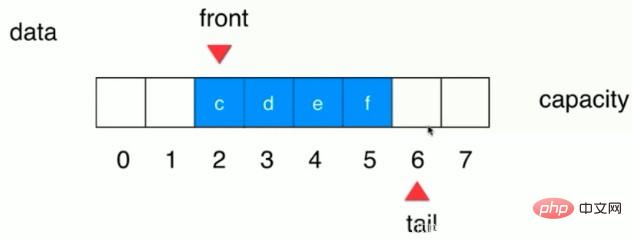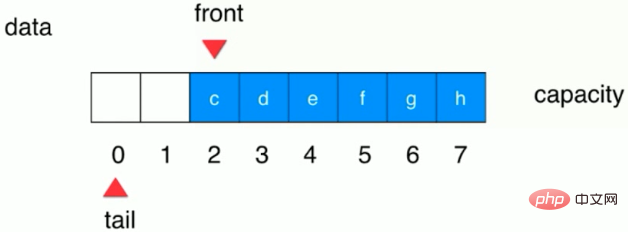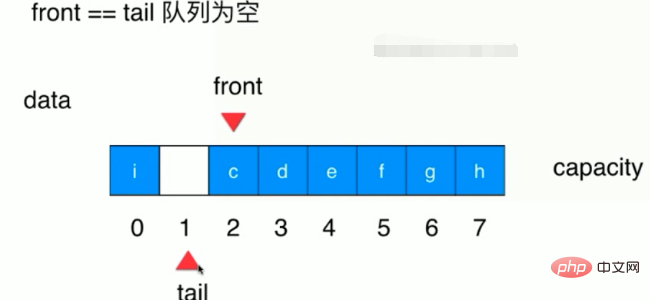Java implements circular queue

Advantages of circular queue
Ordinary queue dequeuing operations are expensive: during dequeuing operations, all elements after index 0 , all need to be moved forward by one position. The more elements there are, the more time is consumed, and the time complexity is O(N).
The logic of the circular queue:
1. When there are few elements (the tail position is behind the front), the circular queue has the same queuing operation as a normal queue. The element of the queue will be placed at the tail position, and then the tail operation will be performed; when the element is dequeued, the element at the front position will be set to null, and then the front operation will be performed; at this time, the tail position can still be maintained behind the front, as follows As shown in the figure:

#2. When elements continue to be added, the last element will be placed at index 7. At this time, the tail position will move to the index in front of the head of the queue. At the position of 0, the index of tail in the array becomes: (tail 1)% capacity as shown in the figure below:

3. When elements continue to be added , the element will be added at the tail position, and the tail will continue to move backward, as shown in the following figure:

#4. Continue to add elements when the tail and front are still one unit apart. At this time, that is, there is still a free storage space in the array, but the current array can no longer implement the insertion operation of the circular queue, because the condition for the circular queue to judge that the queue is empty is front == tail, so expansion operation is required at this time; So there is a conscious waste of space here.
It can be deduced here that the condition for the circular queue element to be full is: tail 1 == front (preliminary conclusion, it will be improved to (tail 1) % capacity == front)
5 . Under appropriate circumstances, if the dequeue operation continues, the position of front will also jump from the right end of the array to the left end of the array. At this time, the index of front in the array becomes: (front 1)% capacity
Code implementation: (Related video tutorial sharing: java video tutorial)
package dataStructure.chapter3;
/**
* @Author: zjtMeng
* @Date: 2019/12/28 20:13
* @Version 1.0
*/
public class LoopQueue<E> implements Queue<E> {
private E[] data;
private int front,tail;
private int size;
public LoopQueue(int capacity){
data = (E[]) new Object[capacity+1];
}
public LoopQueue(){
this(10);
}
public int getCapacity(){
return data.length-1;
}
/**
* 循环队列入队操作
* @param e
*/
@Override
public void enqueue(E e) {
//循环队列元素满的判断条件,如果满了就进行扩容操作,扩大两倍
if ((tail+1)%data.length == front)
resize(2 * getCapacity());
data[tail] = e;
tail = (tail + 1) % data.length;
size ++;
}
/**
* 循环队列扩容
* @param newCapacity
*/
private void resize(int newCapacity){
E[] newData = (E[]) new Object[newCapacity+1];
//循环队列第一种遍历方式
for (int i = 0 ; i < size ; i++ ){
//newData[]中的元素与data[]中的元素,一方面存在着front的偏移量,另一方面,data[]中的元素,
//可能在有部分处于front前面,因此此处采用对数组长度取余,来判断元素的位置
newData[i] = data[(i+front)%data.length];
}
data = newData;
front =0;
tail = size;
}
@Override
public E dequeue() {
//首先判断队列是否为空,如果为空则抛出异常
if (isEmpty())
throw new IllegalArgumentException("Cannot dequeue from an empty queue.");
E ret = data[front];
//引用地址需要置空,否则JVM不能及时回收空间,从而可能会出现OOM异常
data[front] = null;
front = (front + 1 )% data.length;
size--;
//如果元素数量达到队列容积的1/4,且队列容积/2 不等于0时,进行缩容操作
if (size == getCapacity() / 4 && getCapacity() / 2 != 0 )
resize(getCapacity() / 2);
return ret;
}
/**
* 查看队首元素
* @return
*/
@Override
public E getFront() {
if (isEmpty())
throw new IllegalArgumentException("Queue is empty.");
return data[front];
}
@Override
public int getSize() {
return size;
}
/**
* 判断循队列是否为空
* @return
*/
@Override
public boolean isEmpty() {
return front == tail;
}
@Override
public String toString(){
StringBuilder res = new StringBuilder();
res.append(String.format("Queue: size = %d, capacity = %d\n",size, getCapacity()));
res.append("front[");
//循环队列遍历的第二种方法
for (int i = front; i != tail; i = (i + 1) % data.length){
res.append(data[i]);
//循环队列未遍历到队尾的标志
if ((i + 1) % data.length != tail)
res.append(", ");
}
res.append("] tail");
return res.toString();
}
}Recommended related articles and tutorials: java introductory tutorial
The above is the detailed content of Java implements circular queue. For more information, please follow other related articles on the PHP Chinese website!

Hot AI Tools

Undresser.AI Undress
AI-powered app for creating realistic nude photos

AI Clothes Remover
Online AI tool for removing clothes from photos.

Undress AI Tool
Undress images for free

Clothoff.io
AI clothes remover

AI Hentai Generator
Generate AI Hentai for free.

Hot Article

Hot Tools

Notepad++7.3.1
Easy-to-use and free code editor

SublimeText3 Chinese version
Chinese version, very easy to use

Zend Studio 13.0.1
Powerful PHP integrated development environment

Dreamweaver CS6
Visual web development tools

SublimeText3 Mac version
God-level code editing software (SublimeText3)

Hot Topics
 1377
1377
 52
52
 Perfect Number in Java
Aug 30, 2024 pm 04:28 PM
Perfect Number in Java
Aug 30, 2024 pm 04:28 PM
Guide to Perfect Number in Java. Here we discuss the Definition, How to check Perfect number in Java?, examples with code implementation.
 Random Number Generator in Java
Aug 30, 2024 pm 04:27 PM
Random Number Generator in Java
Aug 30, 2024 pm 04:27 PM
Guide to Random Number Generator in Java. Here we discuss Functions in Java with examples and two different Generators with ther examples.
 Weka in Java
Aug 30, 2024 pm 04:28 PM
Weka in Java
Aug 30, 2024 pm 04:28 PM
Guide to Weka in Java. Here we discuss the Introduction, how to use weka java, the type of platform, and advantages with examples.
 Smith Number in Java
Aug 30, 2024 pm 04:28 PM
Smith Number in Java
Aug 30, 2024 pm 04:28 PM
Guide to Smith Number in Java. Here we discuss the Definition, How to check smith number in Java? example with code implementation.
 Java Spring Interview Questions
Aug 30, 2024 pm 04:29 PM
Java Spring Interview Questions
Aug 30, 2024 pm 04:29 PM
In this article, we have kept the most asked Java Spring Interview Questions with their detailed answers. So that you can crack the interview.
 Break or return from Java 8 stream forEach?
Feb 07, 2025 pm 12:09 PM
Break or return from Java 8 stream forEach?
Feb 07, 2025 pm 12:09 PM
Java 8 introduces the Stream API, providing a powerful and expressive way to process data collections. However, a common question when using Stream is: How to break or return from a forEach operation? Traditional loops allow for early interruption or return, but Stream's forEach method does not directly support this method. This article will explain the reasons and explore alternative methods for implementing premature termination in Stream processing systems. Further reading: Java Stream API improvements Understand Stream forEach The forEach method is a terminal operation that performs one operation on each element in the Stream. Its design intention is
 TimeStamp to Date in Java
Aug 30, 2024 pm 04:28 PM
TimeStamp to Date in Java
Aug 30, 2024 pm 04:28 PM
Guide to TimeStamp to Date in Java. Here we also discuss the introduction and how to convert timestamp to date in java along with examples.
 Create the Future: Java Programming for Absolute Beginners
Oct 13, 2024 pm 01:32 PM
Create the Future: Java Programming for Absolute Beginners
Oct 13, 2024 pm 01:32 PM
Java is a popular programming language that can be learned by both beginners and experienced developers. This tutorial starts with basic concepts and progresses through advanced topics. After installing the Java Development Kit, you can practice programming by creating a simple "Hello, World!" program. After you understand the code, use the command prompt to compile and run the program, and "Hello, World!" will be output on the console. Learning Java starts your programming journey, and as your mastery deepens, you can create more complex applications.




